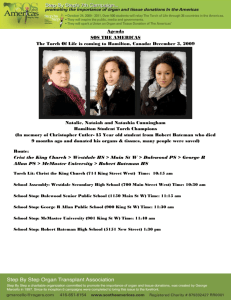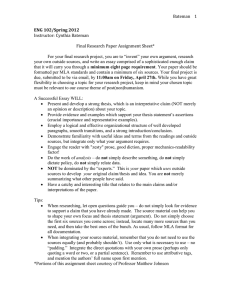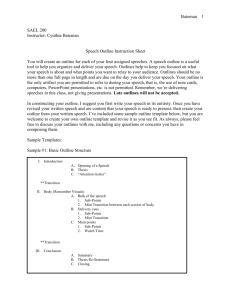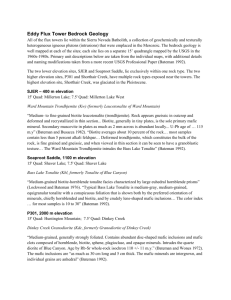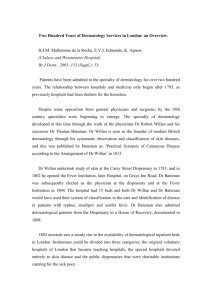Harry Bateman: from Manchester to Manuscript Project *
advertisement
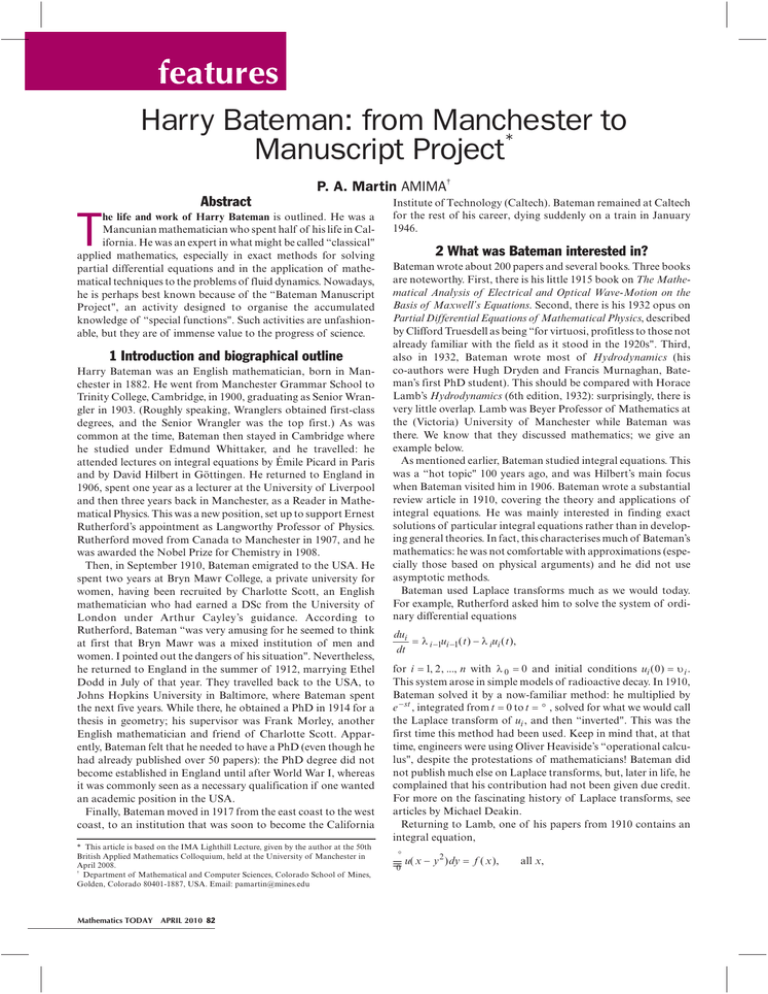
features
Harry Bateman: from Manchester
to
*
Manuscript Project
P. A. Martin AMIMA†
Abstract
he life and work of Harry Bateman is outlined. He was a
Mancunian mathematician who spent half of his life in California. He was an expert in what might be called “classical"
applied mathematics, especially in exact methods for solving
partial differential equations and in the application of mathematical techniques to the problems of fluid dynamics. Nowadays,
he is perhaps best known because of the “Bateman Manuscript
Project", an activity designed to organise the accumulated
knowledge of “special functions". Such activities are unfashionable, but they are of immense value to the progress of science.
T
1 Introduction and biographical outline
Harry Bateman was an English mathematician, born in Manchester in 1882. He went from Manchester Grammar School to
Trinity College, Cambridge, in 1900, graduating as Senior Wrangler in 1903. (Roughly speaking, Wranglers obtained first-class
degrees, and the Senior Wrangler was the top first.) As was
common at the time, Bateman then stayed in Cambridge where
he studied under Edmund Whittaker, and he travelled: he
attended lectures on integral equations by Émile Picard in Paris
and by David Hilbert in Göttingen. He returned to England in
1906, spent one year as a lecturer at the University of Liverpool
and then three years back in Manchester, as a Reader in Mathematical Physics. This was a new position, set up to support Ernest
Rutherford’s appointment as Langworthy Professor of Physics.
Rutherford moved from Canada to Manchester in 1907, and he
was awarded the Nobel Prize for Chemistry in 1908.
Then, in September 1910, Bateman emigrated to the USA. He
spent two years at Bryn Mawr College, a private university for
women, having been recruited by Charlotte Scott, an English
mathematician who had earned a DSc from the University of
London under Arthur Cayley’s guidance. According to
Rutherford, Bateman “was very amusing for he seemed to think
at first that Bryn Mawr was a mixed institution of men and
women. I pointed out the dangers of his situation". Nevertheless,
he returned to England in the summer of 1912, marrying Ethel
Dodd in July of that year. They travelled back to the USA, to
Johns Hopkins University in Baltimore, where Bateman spent
the next five years. While there, he obtained a PhD in 1914 for a
thesis in geometry; his supervisor was Frank Morley, another
English mathematician and friend of Charlotte Scott. Apparently, Bateman felt that he needed to have a PhD (even though he
had already published over 50 papers): the PhD degree did not
become established in England until after World War I, whereas
it was commonly seen as a necessary qualification if one wanted
an academic position in the USA.
Finally, Bateman moved in 1917 from the east coast to the west
coast, to an institution that was soon to become the California
* This article is based on the IMA Lighthill Lecture, given by the author at the 50th
British Applied Mathematics Colloquium, held at the University of Manchester in
April 2008.
†
Department of Mathematical and Computer Sciences, Colorado School of Mines,
Golden, Colorado 80401-1887, USA. Email: pamartin@mines.edu
Mathematics TODAY
APRIL 2010 82
Institute of Technology (Caltech). Bateman remained at Caltech
for the rest of his career, dying suddenly on a train in January
1946.
2 What was Bateman interested in?
Bateman wrote about 200 papers and several books. Three books
are noteworthy. First, there is his little 1915 book on The Mathematical Analysis of Electrical and Optical Wave-Motion on the
Basis of Maxwell’s Equations. Second, there is his 1932 opus on
Partial Differential Equations of Mathematical Physics, described
by Clifford Truesdell as being “for virtuosi, profitless to those not
already familiar with the field as it stood in the 1920s". Third,
also in 1932, Bateman wrote most of Hydrodynamics (his
co-authors were Hugh Dryden and Francis Murnaghan, Bateman’s first PhD student). This should be compared with Horace
Lamb’s Hydrodynamics (6th edition, 1932): surprisingly, there is
very little overlap. Lamb was Beyer Professor of Mathematics at
the (Victoria) University of Manchester while Bateman was
there. We know that they discussed mathematics; we give an
example below.
As mentioned earlier, Bateman studied integral equations. This
was a “hot topic" 100 years ago, and was Hilbert’s main focus
when Bateman visited him in 1906. Bateman wrote a substantial
review article in 1910, covering the theory and applications of
integral equations. He was mainly interested in finding exact
solutions of particular integral equations rather than in developing general theories. In fact, this characterises much of Bateman’s
mathematics: he was not comfortable with approximations (especially those based on physical arguments) and he did not use
asymptotic methods.
Bateman used Laplace transforms much as we would today.
For example, Rutherford asked him to solve the system of ordinary differential equations
dui
= λ i −1ui −1( t ) − λ iui ( t ),
dt
for i = 1, 2 , ..., n with λ 0 = 0 and initial conditions ui ( 0 ) = υ i .
This system arose in simple models of radioactive decay. In 1910,
Bateman solved it by a now-familiar method: he multiplied by
e − st , integrated from t = 0 to t = ∞, solved for what we would call
the Laplace transform of ui , and then “inverted". This was the
first time this method had been used. Keep in mind that, at that
time, engineers were using Oliver Heaviside’s “operational calculus", despite the protestations of mathematicians! Bateman did
not publish much else on Laplace transforms, but, later in life, he
complained that his contribution had not been given due credit.
For more on the fascinating history of Laplace transforms, see
articles by Michael Deakin.
Returning to Lamb, one of his papers from 1910 contains an
integral equation,
∞
∫0 u( x − y
2
) dy = f ( x ),
all x,
where f is given and u is to be found. Lamb gives a solution in the
form of a double integral, but then adds a footnote: “Mr. H.
Bateman, to whom I submitted the question, has obtained a
simpler solution", followed by a formula but with no indication
of how Bateman obtained it. Here is Bateman’s solution:
u( x ) =
2 ∞ f ′( − y ) dy
.
π ∫− x x + y
The reader may wish to derive this solution using Fourier
transforms.
3 Bateman and the wave equation
Inevitably, Bateman was interested in partial differential equations (PDEs). In particular, he was interested in finding solutions
involving arbitrary functions (not just arbitrary constants), and
in finding transformations between solutions of the same PDE or
between solutions of different PDEs. To give a taste of what
Bateman liked, start with the one-dimensional wave equation,
∂ 2w
∂x 2
=
1 ∂ 2w
c 2 ∂t 2
.
It is an undergraduate exercise to verify d’Alembert’s general
solution,
w ( x, t ) = f ( x − ct ) + g( x + ct ),
where f and g are arbitrary smooth functions of one variable.
There is a similar result for the three-dimensional wave equation,
∂ 2w
∂x 2
+
∂ 2w
∂y 2
+
∂ 2w
∂z 2
=
1 ∂ 2w
c 2 ∂t 2
.
For this PDE, the general spherically symmetric solution is given
by
w ( x, y, z , t ) = R −1{ f ( R − ct ) + g( R + ct )},
2
2
2
where R = ( x + y + z ) is a spherical polar coordinate: the
solution given does not depend on the other two spherical polar
coordinates.
What happens in two dimensions? In this case, the PDE is
∂ 2w
∂x
2
+
∂ 2w
∂y
2
=
1 ∂ 2w
c 2 ∂t 2
.
We can introduce plane polar coordinates, r and θ, given by
x = r cosθ, y = r sinθ, and then look for cylindrically symmetric
solutions that resemble the d’Alembert solution. It turns out that
there are none. The closest one can get is
w (( x, y, t ) = r −1/ 2{ f ( r − ct ) + g( r + ct )} cos( θ / 2 ),
which involves the angle θ. Bateman liked and used this solution
(which he attributed to Poisson): it is simple but seldom seen in
textbooks on PDEs.
To illustrate some of Bateman’s transformation, suppose that
w ( x, y, z , t ) solves the three-dimensional wave equation. Then so
do s −2w ( x / s 2, y / s 2, z / s 2, t / s 2 ) and
x
y
s2 −1
s2 +1
1
,
,
,
,
w
z − ct z − ct z − ct 2 ( z − ct ) 2 c ( z − ct )
where s 2 = r 2 − c 2t 2. The first of these looks plausible (it resembles Kelvin inversion for Laplace’s equation) but the second is
surprising.
Bateman’s fascination with transformations dates back to his
studies of the Lorentz transformation, which leaves Maxwell’s
equations invariant. Bateman and Ebenezer Cunningham
looked for generalisations of the Lorentz transformation; they
found them, and they showed that they form a 15-parameter
group.
Bateman was also interested in Maxwell’s equations because,
especially in the time before quantum mechanics, much of Cambridge mathematical physics was directed at “æther theories", the
idea that electronic theories of matter could be built. Thus, he
constructed elaborate exact solutions of Maxwell’s equations:
see his 1915 book for more details.
4 Bateman and fluid dynamics
In 1914, while he was at Johns Hopkins University, Bateman
began working in fluid dynamics. His motivation was simple:
money! To supplement his income, he worked for the U.S.
Weather Bureau, initially reviewing papers. He wrote four papers
for the Monthly Weather Review (MWR). These covered the
behaviour of real fluids, such as sound propagation in the
moving atmosphere, with detailed literature surveys: this is
typical of Bateman’s scholarly approach. The papers also include
some results of his own researches. His 1915 MWR paper
includes a study of the behaviour of solutions to the
Navier-Stokes equations as the viscosity v → 0. Thus, he considered the possibility that the limiting form may be discontinuous:
this “possibility … may perhaps be illustrated by a consideration
of the equation”
∂u
∂u
∂ 2u
+u
=v
,
∂t
∂x
∂x 2
a nonlinear PDE for u. Bateman sought (non-constant) travelling-wave
solutions,
whence
u( x, t ) = f ( x − Ut ),
( f − U ) 2 + A = 2 vf ′, where A and U are constants. If A > 0, there
is no limit as v → 0. If A = − a 2 < 0, we can integrate to obtain
u −U − a
a
= exp ( x − Ut + C ) ,
u −U + a
v
where C is another constant. Then, u → U ± a as v → 0, where the
sign is taken as the sign of x − Ut + C . Bateman remarks that it “is
clear from this example that the question of the limiting form of
the motion of a viscous fluid when the viscosity tends to zero
requires very careful investigation".
Bateman’s nonlinear PDE is usually known as the “Burgers
equation", although J. M. Burgers did not study it until the 1940s.
Again, Bateman was unlucky!
Bateman’s work on fluid dynamics must have been a factor in
his recruitment by Caltech. Southern California was home to a
growing aviation industry, so it made sense for this to be reflected
in a growing research university. Bateman wrote reports for the
National Advisory Committee for Aeronautics (NACA, later
NASA) and the book Hydrodynamics mentioned above. Unlike
Lamb’s Hydrodynamics, Bateman gives lengthy discussions of
viscous flows and of turbulent flows.
Theodore von Kármán moved to Caltech in 1930. His vitality
and influence are legendary, and he attracted many excellent
Mathematics TODAY
APRIL 2010 83
graduate students. One of his major research topics in the 1930s
was high-speed compressible flow: it is not surprising that
Bateman became involved with related theoretical studies. Two
of von Kármán’s students were Francis and Milton Clauser: they
were identical twins. Unusually, they co-authored two PhD
theses in 1937, one on wind-tunnel experiments and one entirely
theoretical (on the hodograph method, supervised by Bateman).
Today, one cannot imagine a University Registrar permitting
such behaviour!
5 Special functions
In 1945, Bateman estimated that there were about 1400 documented special functions (including several that he had defined).
He was not interested in special functions for their own sake, but
only as they arose in the solution of various applied problems.
For example, he once solved a differential equation for von
Kármán, namely,
xu′′( x ) = ( x − v )u( x ),
where v is a paramater. Bateman gave one solution:
kv ( x ) =
2 π/2
cos ( x tan θ − vθ ) dθ.
π ∫0
This defines what is now known as “Bateman’s function".
Nevertheless, Bateman accumulated facts and formulae involving special functions, much as a philatelist collects postage
stamps. He recorded everything on index cards and scraps of
paper, which he kept in dozens of cardboard boxes, famously
described as “Bateman’s shoe-boxes". He planned to compile all
this information into some kind of encyclopedia of special functions: he was certainly familiar with all the relevant literature and
so, in principle, he was the ideal man for the job. Two things
thwarted his plan. First, he was probably incapable of organising
everything into a coherent whole. Second, he died suddenly.
Bateman left behind his shoe-boxes and many unfinished
attempts at writing books. The “Bateman Manuscript Project"
(BMP) was created so as to disseminate some of this material.
The Director of the BMP was Arthur Erdélyi. He was a Hungarian mathematician at the University of Edinburgh. He had been
recommended for the position by Whittaker, who was the Professor of mathematics at Edinburgh. The other BMP Research
Associates were Wilhelm Magnus, Fritz Oberhettinger and
Francesco Tricomi. All four had published extensively on special
functions and their applications.
The output of the BMP was published as five red books in the
1950s. Three of the five are on “Higher Transcendental
Functions" (HTF). The other two give tables of integrals. (The
first HTF volume describes the genesis of BMP in some detail.)
The HTF volumes have proved to be very influential. They
contain lots of formulae (as you might expect), which makes
them useful to applied mathematicians and other scientists, but
this does not account for their lasting influence, as other sources
of formulae are readily available. Arguably, the strength of the
HTF books is that they outline how the formulae can be
obtained, and this can be suggestive of new formulae, thus
promoting further research.
6 Why is Bateman interesting today?
By all accounts, Bateman was not an exciting individual: he lived
for mathematics. The functional analyst Angus Taylor took
Mathematics TODAY
APRIL 2010 84
classes from Bateman when he was a graduate student at
Caltech. He evokes the man thus: “Bateman was a mild, shy man
with a kind and generous heart; to shake his hand was like grasping a leaf of wilted lettuce".
Bateman is interesting today because of his mathematics (of
course!) and for his understated influence: he taught many students at Caltech, and many of those have noted his influence on
their work. Examples are Linus Pauling, Charles Richter, Clifford Truesdell and John Miles. Bateman is also interesting
because he was a pioneering American applied mathematician:
there was very little applied mathematics in the USA until the
middle of World War II. Indeed, Bateman was appointed at
Caltech as “Professor of Aeronautical Research and Mathematical Physics", and this title does describe the areas where most of
his “applied" contributions fall.
Today, if we remember Bateman at all, we usually associate his
name with the Bateman Manuscript Project and its five
well-known red books on the theory of special functions and
integral transforms. These books have been used by several generations of mathematicians. Another five books, giving a new
Encyclopedia of Special Functions (edited by Mourad Ismail
and Walter Van Assche), are expected from the “Askey-Bateman
Project". Therefore, we may anticipate a revival of interest in
Bateman and his work.
We end with a few more extracts and assessments, beginning
with one from Francis Murnaghan:
Bateman’s best work centered around the development of the properties of special functions and the solution of the equations of Mathematical Physics. . . . The field in which [he] stood preeminent was that
of electrodynamics. . . .Modest, reserved, cultured and self-effacing he
was, in its true sense, a gentle man. He was very English and he must
have long looked back over his shoulder, before becoming, in 1927, a
citizen of the new exuberant country in which he spent more than half
his life, to the quiet England of Victoria and Edward VII.
E.T. Bell was one of Bateman’s colleagues at Caltech; today, he is
perhaps best known for his lively (but flawed) history, Men of
Mathematics, first published in 1937 and still in print. His assessment is as follows:
Bateman was an almost unique combination of erudition and creativeness. It is most unusual for a mathematician to have the extraordinary
range of exact knowledge that Bateman had, and not be crushed into
sterility by the mere burden of an oppressive scholarship. But, as his
numerous publications testify, Bateman retained his creative originality till his death. In pure mathematics, his dominating interest was in
the analysis that has developed from classical mathematical physics.
His technical skill in this broad field was unrivalled. His numerous
contributions to mathematical physics are marked by a vivid, at times
almost romantic, imagination.
These extracts are taken from two of Bateman’s obituaries.
Writing 30 years later, Truesdell gave the following assessment:
[Bateman] was not an interdisciplinarian, because for him there were
no disciplines. He saw the mathematical sciences as a continuum with
no compartments; the center of his interest was the mathematics of
physical problems and the physical interpretations of mathematics. …
He saw no difference in style or standard between pure mathematics
and applied, between mathematics and theoretical physics, between
physics and its application. From the great range of Bateman’s interest
you might expect his papers to be superficial, but they are by no means
so. Each one displays virtuosity, but the choice of problem is sometimes more for its difficulty or curiosity than for its importance. In a
period of increasing specialization Bateman remained a natural
philosopher.
Perhaps Bateman would have liked to have been described as a
“natural philosopher" with a “vivid, romantic imagination" and
“unrivalled technical skills"?
7 Further information
The first place to go for information about mathematicians is the
MacTutor History of Mathematics archive at the University of
St. Andrews: http://www-history.mcs.st-andrews.ac.uk/
Bateman’s page contains three pictures and it cites obituaries by
Erdélyi and Bell. There are others by Murnaghan and by R. C.
Archibald. Truesdell’s essay, “Genius and the establishment at a
polite standstill in the modern university: Bateman", was published
in 1984. Bateman’s papers are held at Caltech; for information and
many pictures, go to http://www.archives.caltech.edu/
Bateman’s 1915 book on Maxwell’s equations is freely available on
the web, as is his 1918 textbook, Differential Equations, and his four
papers in the Monthly Weather Review. His major book on PDEs
and the book on hydrodynamics were both reprinted by Dover;
used copies are easy to find.
I have accumulated much information about Bateman’s life and
work; perhaps a book will emerge one day. If you have comments,
suggestions or anecdotes, please contact me.❏
View from the Pennines:
Mind the (Generation) Gap
Paul Glendinning, School of Mathematics, University of Manchester, Manchester M13 9PL.
man who fought in the Great War is remembered with a
mixture of awe and fear by the older men in the village. He
lived alone on the side of the valley, and was said to have
had a ‘good war’. A bit of probing reveals that this means he was
surly and ill-disciplined, but good at killing. One story in particular is used to illustrate this. A young officer asked him to find a
German helmet as a trophy for the officer to display. Our man
was scornful that the officer needed his help, but slipped across to
the German lines, killed a man and returned to the officer, nonchalantly throwing the helmet into the officer’s lap. The officer
jumped up screaming: the previous owner’s head was still
attached.
This is a brutal tale of a brutal time. And it is worth remembering just what war entails as modern reporting can give it a different gloss. As someone who (thankfully) has never experienced
war, or any extreme of violence, it also emphasizes just how much
the experience of different generations can vary.
Research into, and the teaching of, mathematics are human
activities and hence they are not immune to the vagaries and particularities of the time in which they are practiced, nor the people
who practice them. I have long crossed the threshold from being a
(fairly) trendy young lecturer who speaks a language closer to
that of the students than that of more senior colleagues, to being
a senior colleague – a grey-hair – myself. And, oh dear, I am listening to David Bowie as I type this rather than the Arctic
Monkeys (hang on a sec while I change the CD... no I don’t have
an i-Pod).
Does this matter? This transition is inevitable and probably
needs to be accepted with a degree of good grace. My concern,
however, is that it is affecting my teaching. I have always felt that I
am a good lecturer – students seem to enjoy my classes and I have
had good feedback from them. But as I grow older there is a
larger distance between me and them, and I am beginning to
wonder whether my style has moved out of fashion. On the face
of it this is acceptable, but if the style starts hindering the learning process it becomes a problem.
As a starting point for a discussion of this dilemma – a dilemma
which must occur in the life of almost all academics to a greater
or lesser extent – I thought back to the lecturers who enthused me
A
as a student, and those that bored or irritated me. Those I liked at
Cambridge (Beardon, Körner, Landshoff and Moffat come to
mind) all had a relaxed delivery, and spent time motivating the
material, helping students to appreciate the relative importance
of results and develop intuition. To take two examples: Alan
Beardon always provided a sketch proof of a result in analysis,
literally a picture with a narrative, before writing down the
‘proper’ proof. Tom Körner emphasized the centrality of
Cauchy’s Theorem to a course on Complex Analysis by repeatedly advertising the date on which it would be proved – ‘if you
insist on coming to only one of my lectures come to the lecture on
February 24th for the proof of Cauchy’s Theorem’. We were not
disappointed.
The lectures I found harder were well-structured and considered, but gave no hint of why something was worth doing, nor
how results fitted together. I suspect that these (generally older)
lecturers felt that any such discussion was redundant; their function was to provide us with the techniques and material which we
should then weave into narrative and use to develop our own
intuition as part of our transformation into mature mathematicians. To actually provide this explicitly would be otiose and even
ridiculous. I am sure they viewed our obvious preference for the
younger lecturers with a mixture of exasperation and disapproval
– why did we want to be spoon-fed in this way? Why were we so
reluctant to do the thinking for ourselves?
It is tempting to link these two contrasting approaches to the
social and political backgrounds of the different generations.
Those educated in the earlier part of the twentieth century would
have been used to very formal approaches to teaching, and would
therefore have cultivated from an early age the skill of creating
narratives and understanding the nuances of the formal education they received. There would also have been an emphasis on
self-reliance (though this may not have extended to financial
matters, as they would have been overwhelmingly from privileged
backgrounds).
The younger generation had experienced the liberation of the
1960s after the rigours of the Second World War and post-war
rationing. The cultural background shifted, imagination and creativity ruled leading to a more relaxed approach to material and
Mathematics TODAY
APRIL 2010 85
